*We are a reader-supported website. When you buy through links on our site, we may earn a small affiliate commission at no extra cost to you. Home Media Entertainment does not accept money for reviews.*
Introduction
Lighting plays a crucial role in creating a captivating and immersive home theater experience. Therefore, in this “Home Theater Lighting Ideas for Beginners” guide, we’ll delve into the art of home theater lighting, exploring various ideas and tips that are perfect if you are relatively new to all this. Whether you’re setting up a new home theater or looking to enhance your existing setup, understanding how to use lighting effectively can make a world of difference.

Why Lighting Matters
When you step into a cinema, you’re not just watching a movie; you’re entering a world of storytelling and emotion. The same can be true for your home theater. Because lighting is the unsung hero that sets the stage, influences mood, and transforms your living room into a cinematic wonderland. It’s more than just seeing what’s on the screen; it’s about feeling the atmosphere, anticipating every twist, and getting lost in the magic of cinema.
What to Expect
In this article, we’ll start by covering the basics of home theater lighting, including the various types of lighting you can use, the importance of proper placement and intensity, and creating a comfortable viewing environment. We’ll then explore the selection of light fixtures, setting the mood with colors, dimmer controls, and smart lighting options.
As we progress, we’ll delve into strategic placement strategies, DIY lighting projects, and practical maintenance tips. So, if you’re ready to transform your home theater into a realm of cinematic delight, let’s dive into the world of home theater lighting and discover how a well-lit space can elevate your movie nights to a whole new level.
Chapter 1: Understanding the Basics
Types of Home Theater Lighting
Before we delve into the specifics of home theater lighting, it’s essential to understand the different types of lighting that can contribute to your cinematic experience.
- Ambient Lighting: Ambient lighting provides overall illumination in the room. It’s the base layer of light that ensures you can move around safely. In a home theater context, it should be soft and non-intrusive to avoid washing out the screen.
- Task Lighting: Task lighting is focused and directed lighting used for specific activities, such as reading a magazine or setting up your equipment. In a home theater, task lighting can be handy for things like finding the remote control.
- Accent Lighting: Accent lighting adds drama and visual interest by highlighting specific elements in the room, such as posters, artwork, or architectural features. In your home theater, accent lighting can draw attention to your movie memorabilia or a themed wall.
The Art of Placement and Intensity
While understanding the types of lighting is crucial, knowing where and how to place them is equally important. The right placement and intensity can make or break your home theater’s atmosphere.
For instance, when it comes to ambient lighting, consider using dimmable fixtures and placing them strategically to avoid screen glare. Task lighting should be adjustable to avoid distractions during the movie but provide enough light for other activities.
Accent lighting, on the other hand, should be carefully aimed to showcase your prized possessions without casting unwanted shadows. The key is finding a balance that suits your viewing preferences and creates a comfortable environment.
Creating a Comfortable Viewing Environment
In a home theater, comfort is paramount. Lighting not only affects what you see but also how you feel while watching a movie. Because harsh, glaring lights can be distracting and uncomfortable. Here are some tips to ensure a comfortable viewing environment:
- Invest in dimmer switches for your ambient lighting. This way you can adjust brightness according to the content on the screen.
- Use soft, diffused task lighting to read menus or find items without disrupting the movie experience.
- Consider wall-mounted or remote-controlled fixtures for easy adjustments during your movie nights.
- Think about the color temperature of your lighting. For example warmer tones can create a cozy and inviting atmosphere.
In any case understanding the basics of home theater lighting sets the foundation for creating a space where you can fully immerse yourself in your favorite films.
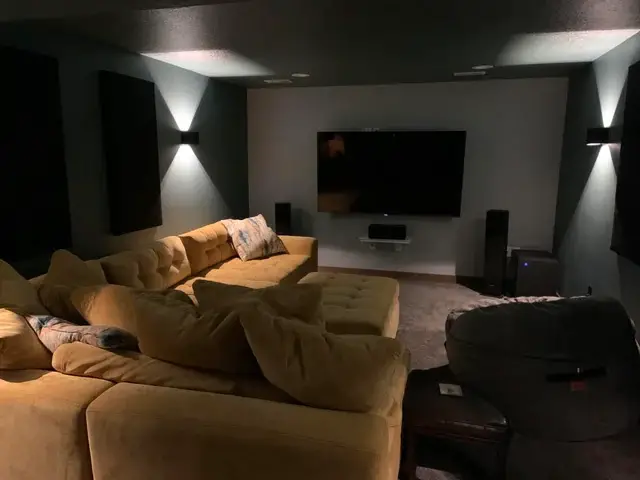
Chapter 2: Choosing the Right Light Fixtures
Exploring Lighting Fixture Types
When it comes to home theater lighting, selecting the right fixtures can make a significant difference in both aesthetics and functionality. Let’s explore some common types of light fixtures you can consider:
- Recessed Lighting: Recessed lights are sleek and unobtrusive. For that reason they are often used for ambient lighting and can be installed in the ceiling to create a clean, minimalist look. They are an excellent choice for modern home theaters.
- Wall Sconces: Wall sconces are decorative fixtures that can add a touch of elegance to your home theater. They are typically mounted on the walls and can provide ambient or accent lighting. Subsequently choose sconces that complement your room’s style.
- Floor Lamps: Floor lamps are versatile and can be moved around to adjust lighting levels as needed. They work well as task lighting for reading or as supplementary ambient lighting. For this reason consider lamps with adjustable heads for flexibility.
- LED Strips: LED strips are a popular choice for adding a modern, futuristic vibe to your home theater. They can be installed along walls, behind your TV, or even under furniture to create unique lighting effects. LED strips are ideal for accent lighting.
Affordable Lighting Solutions
For beginners on a budget, there are cost-effective lighting options that can still deliver impressive results. Here are a few budget-friendly considerations:
- LED Bulbs: If you already have standard light fixtures, consider replacing the bulbs with LED bulbs. Not only they are energy-efficient and long-lasting but also come in various color temperatures.
- DIY Lighting Projects: As we’ll explore later in this guide, there are DIY home theater lighting projects that won’t break the bank. From creating your own LED backlighting for your TV to crafting custom accent lights, DIY projects can be both fun and budget-friendly.
- Online Deals and Sales: Keep an eye out for online deals, discounts, and sales on lighting fixtures. Because many retailers offer promotions that can help you save on your home theater lighting upgrades.
Design Harmony
To create a cohesive and visually pleasing home theater, it’s essential to match your lighting fixtures with the overall decor and theme of the room. Here are some tips:
- Choose Fixtures That Complement: Select fixtures that harmonize with your furniture, color scheme, and overall style. For instance, if your home theater has a vintage vibe, consider retro-style fixtures.
- Consider Color Temperature: The color temperature of your lighting should align with the ambiance you want to create. Warmer temperatures (e.g., 2700K) can make the space feel cozy, while cooler temperatures (e.g., 4000K) lend a more modern feel.
- Don’t Overdo It: While lighting is crucial, avoid overcrowding the space with too many fixtures. Because a well-thought-out lighting plan with the right balance of ambient, task, and accent lighting can achieve a stunning effect.
Choosing the right light fixtures is a crucial step in transforming your home theater into a cinematic haven.
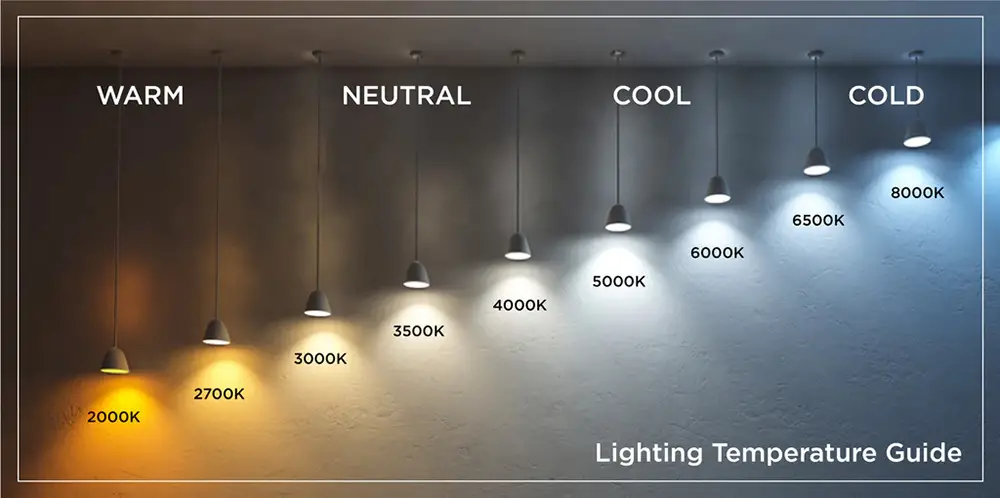
Chapter 3: Setting the Mood with Color
Choosing the Right Color Temperature
Color temperature is a fundamental aspect of home theater lighting, because it can greatly influence the mood and ambiance of your viewing experience. Here’s how to select the ideal color temperature for your home theater:
Warm and Cozy (2700K – 3000K): If you want to create a warm, inviting atmosphere reminiscent of classic movie theaters, opt for bulbs with a color temperature in the 2700K to 3000K range. This soft, amber-toned lighting is perfect for cozy movie nights.
Neutral and Balanced (3500K – 4000K): For a more contemporary and versatile ambiance, choose bulbs in the 3500K to 4000K range. This neutral, daylight-like lighting can provide clarity and enhance your overall viewing experience.
Cool and Modern (5000K – 6500K): If you’re aiming for a sleek, modern look in your home theater, consider bulbs with a color temperature of 5000K to 6500K. These cooler tones create a crisp, vibrant environment that’s ideal for action-packed movies and gaming.
Enhancing Atmosphere with Color-Changing LEDs
Color-changing LED lights offer a dynamic way to set the mood in your home theater. Because these versatile lights can shift between various colors, they allow you to customize your lighting to match your movie genres and themes. Here’s how to use them effectively:
Movie Genre Themes: Tailor your lighting to match the genre of the film you’re watching. For a horror movie night for example, choose deep reds or eerie blues. For a romantic comedy on the other hand, go for warm pinks and soft purples.
Immersive Experiences: Many color-changing LED systems sync with your media. They can change colors and intensity based on what’s happening on the screen, immersing you even further into the story.
Accent Lighting: Place color-changing LED strips behind your TV or along the walls to create vibrant accents that complement your decor and elevate the cinematic experience.
Enhancing the Storytelling
To illustrate, imagine watching a sci-fi epic bathed in a futuristic blue glow or a thrilling adventure movie surrounded by the fiery intensity of red and orange lighting. Coordinating colors with movie genres and themes can elevate your home theater experience to a whole new level.
- Action Movies: Vibrant and dynamic colors like red, orange, and intense blue can enhance the adrenaline rush in action-packed scenes.
- Romantic Films: Soft, warm hues like pink and purple can create a cozy, romantic atmosphere, perfect for heartwarming moments.
- Sci-Fi and Fantasy: Cool blues and greens can transport you to otherworldly realms, making sci-fi and fantasy films even more captivating.
Consequently by integrating color temperature and color-changing LED lights into your home theater setup, you can craft a truly immersive and visually engaging cinematic space.
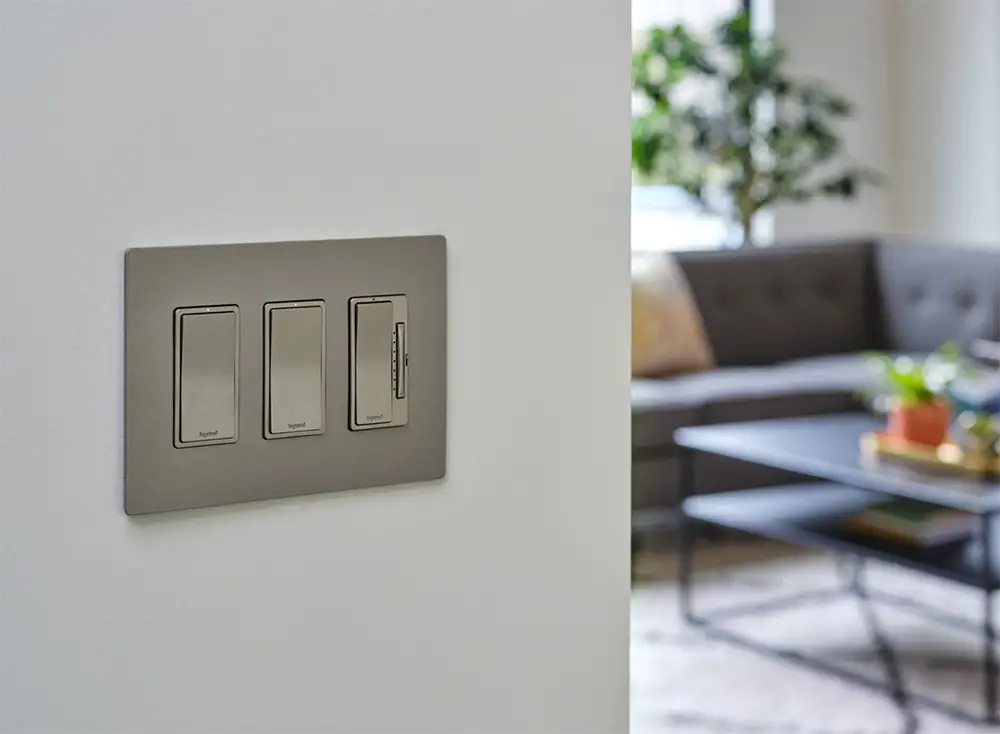
Chapter 4: Dimmer Controls and Smart Lighting
Enhancing Control with Dimmer Switches
Dimmer switches are a valuable addition to your home theater lighting setup. Because they offer precise control over the intensity of your lights. Here’s why they are essential:
Adjustable Ambiance: Dimmer switches allow you to fine-tune the brightness in your home theater. You can lower the lights during movie viewing for an immersive experience and then increase them when you need to move around or read.
Reduced Glare: By dimming your ambient lighting, you can significantly reduce screen glare and reflections, ensuring that the focus remains on the movie or TV show.
Energy Efficiency: Dimming your lights can also save energy and extend the lifespan of your bulbs. You’ll use only the amount of light you need, reducing electricity consumption.
Unlocking Smart Lighting Benefits
In the age of smart technology, integrating a smart lighting system into your home theater can be a game-changer. Here are some advantages to consider:
- Voice Control: With smart lighting, you can control your home theater lights using voice commands. For example you tell your virtual assistant to “dim the lights for movie night,” and watch the magic happen.
- Smartphone Apps: Many smart lighting systems come with dedicated apps that allow you to create custom lighting scenes, schedules, and color presets. You can control your lights remotely, even when you’re not at home.
- Integration with Home Automation: Smart lighting can seamlessly integrate with other smart home devices. As a result you can sync your lighting with your home theater equipment, creating a fully immersive experience that syncs lighting with the action on the screen.
Smart Lighting on a Budget
You don’t need to break the bank to enjoy the benefits of smart lighting in your home theater. Therefore here are some affordable smart lighting product recommendations:
- Smart Bulbs: Brands like Philips Hue and Wyze offer budget-friendly smart bulbs that can be controlled via smartphone apps or voice commands.
- Smart Plugs: If you already have regular bulbs, consider smart plugs that can turn your existing fixtures into smart lights. These are often more affordable than replacing all your bulbs.
- Starter Kits: Look for starter kits that include a hub and a few smart bulbs. These kits can provide a cost-effective entry point into the world of smart lighting.
Integrating dimmer controls and smart lighting technology into your home theater not only enhances convenience but also adds an extra layer of customization and immersion to your cinematic experience.
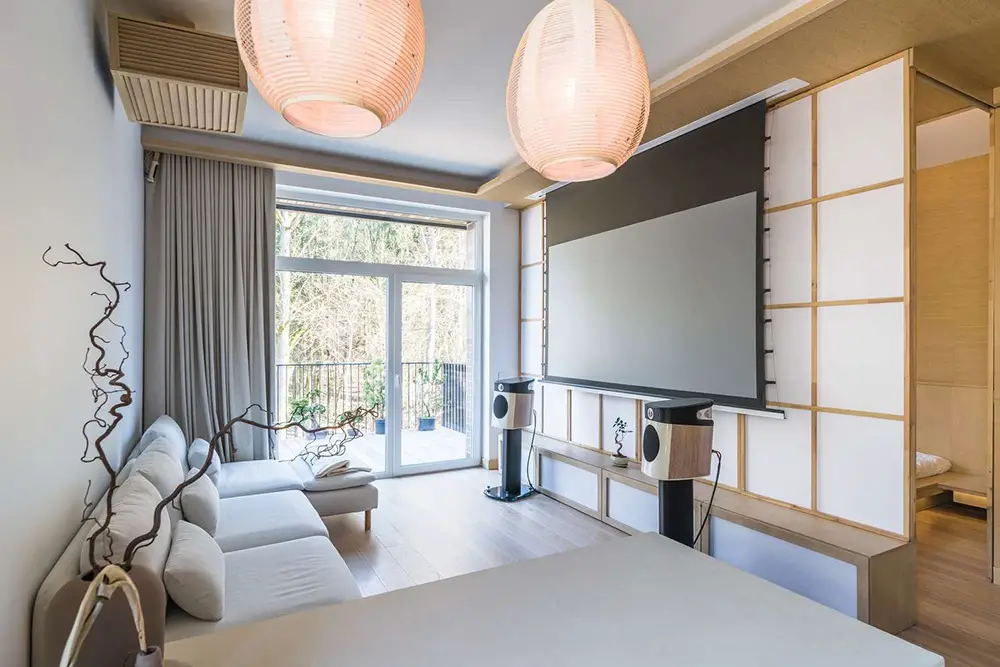
Chapter 5: Lighting Placement Strategies
Strategic Lighting Placement
In your home theater, the placement of lights is crucial to ensure that you achieve the best possible viewing experience. Here’s how to position your lights for optimal results:
Avoid Screen Glare: When positioning ambient lighting, ensure that no direct light falls onto the screen. Ceiling-mounted fixtures or wall sconces with shades can help diffuse light and prevent glare.
Task Lighting Precision: If you have task lighting for activities like reading or setting up equipment, place it strategically. Adjustable lamps or fixtures should be positioned so that the light is focused where it’s needed without spilling onto the screen.
Accentuate Key Elements: For accent lighting, such as highlighting movie posters or artwork, position fixtures to showcase these elements effectively. Wall-mounted fixtures or track lighting can work well for this purpose.
Minimizing Glare and Reflections
Glare and reflections on your screen can be distracting and diminish the quality of your viewing experience. To reduce glare and reflections:
Use Matte Surfaces: Opt for matte finishes on walls and ceilings to minimize reflections. Dark-colored surfaces are also less likely to reflect light.
Light Control: Consider investing in blackout curtains or blinds to block external light sources, especially if your home theater has windows. Additionally, use dimmers to control ambient lighting during movie time.
Anti-Glare Screens: Some home theater screens come with anti-glare coatings or materials that can help reduce reflections. If possible, choose a screen designed to mitigate glare.
Adding Depth and Dimension
Strategic lighting can create a sense of depth and dimension in your home theater, making it feel more immersive. Here’s how:
Wall Washing: Use wall-washing techniques, where light fixtures are placed to cast a soft, even light across the walls. This can make your space feel larger and enhance the visual appeal.
Layered Lighting: Combine different types of lighting, such as ambient, task, and accent lighting, to create layers of illumination. This adds depth to your room and allows you to adjust lighting according to your needs.
Backlighting: Consider backlighting elements like shelves or your TV screen. Backlighting can add depth and a touch of drama to your home theater setup.
By carefully positioning your lights, minimizing glare and reflections, and using strategic lighting techniques, you can create a home theater space that not only looks fantastic but also enhances your movie-watching experience.

Chapter 6: DIY Home Theater Lighting Projects
DIY Lighting Projects for Personalized Ambiance
For those who enjoy a hands-on approach and want to add a personal touch to their home theater lighting, here’s a step-by-step guide for creating custom lighting solutions:
- LED Strips Behind the TV:
- Measure the dimensions of your TV.
- Purchase LED strips in the desired color.
- Attach the LED strips to the back of the TV using adhesive backing or specialized TV LED strip mounts.
- Connect the LED strips to a power source and controller.
- Adjust the color and intensity of the lighting to your preference.
- Building a DIY Starry Ceiling:
- Create a fiber optic starry effect by drilling holes in the ceiling.
- Insert fiber optic strands through the holes, leaving the ends exposed.
- Connect the exposed ends to a light source or LED projector.
- Adjust the color and intensity to mimic a starry night sky.
- Crafting Movie Poster Backlit Frames:
- Choose your favorite movie posters.
- Purchase poster frames with built-in LED backlighting or retrofit existing frames with LED strips.
- Mount the posters in the frames and hang them on the walls.
- Adjust the lighting to highlight the posters effectively.
Affordable DIY Options
Creating custom lighting solutions for your home theater doesn’t have to be expensive. Here are some budget-friendly materials and tools:
- LED Strips: LED strips are cost-effective and versatile for various DIY projects. They come in various lengths and colors.
- Fiber Optic Kits: Fiber optic kits for creating starry ceilings are readily available and can be found at reasonable prices.
- Adhesive and Mounting Materials: Ensure you have adhesive, brackets, or mounts suitable for the specific DIY project you’re undertaking.
- Basic Tools: Have basic tools like a drill, screwdriver, measuring tape, and wire cutters on hand for installation.
Safety First
When engaging in DIY home theater lighting projects, safety should be a top priority. Here are some essential safety precautions to keep in mind:
- Read Instructions: Always read and follow the manufacturer’s instructions for the materials and tools you use.
- Electricity Safety: If your DIY project involves wiring or electrical work, ensure you turn off the power to the area before starting. If you’re uncertain, consult an electrician.
- Safety Gear: Wear appropriate safety gear, such as gloves and safety goggles, when handling tools and materials.
- Secure Installations: Ensure that all fixtures and installations are secure to prevent accidents or damage.
DIY lighting projects offer a fantastic way to add a unique touch to your home theater while staying within your budget.

Chapter 7: Practical Tips for Maintenance
Cleaning and Maintaining Your Lights
Proper maintenance ensures that your home theater lighting continues to perform optimally and look its best. Here are practical tips for cleaning and maintaining light fixtures:
- Regular Dusting: Dust and dirt can accumulate on light fixtures over time. Use a microfiber cloth or a duster to gently remove dust from fixtures, bulbs, and shades.
- Cleaning Glass Fixtures: If you have glass or crystal fixtures, use a mixture of water and a mild glass cleaner to clean them. Avoid using abrasive cleaners that can scratch the glass.
- Changing Bulbs: Regularly check and replace bulbs as needed. Using LED bulbs can extend the time between replacements.
- Inspect Wiring: Periodically inspect the wiring of your fixtures for any signs of wear or damage. Ensure that all connections are secure.
Replacing Bulbs and LED Strips
When it’s time to replace bulbs or LED strips in your home theater lighting setup, follow these steps:
- Turn Off Power: Before replacing any bulbs or working with LED strips, turn off the power to the fixtures to ensure your safety.
- Choose the Right Bulbs: When replacing bulbs, make sure to choose bulbs with the same wattage and type as the ones you are replacing. If using LED strips, check for compatibility with your existing setup.
- Proper Installation: Ensure that bulbs are screwed in securely but not too tight. For LED strips, follow the manufacturer’s installation instructions carefully.
Troubleshooting Common Lighting Issues
Sometimes, lighting issues can arise. Here are some common problems and troubleshooting tips:
- Flickering Lights: Flickering lights can be caused by loose bulbs, wiring issues, or dimmer switch problems. Therefore tighten bulbs, check wiring connections, and inspect all dimmer switches.
- Uneven Lighting: If you notice uneven lighting in your home theater, adjust the placement of fixtures or add additional lighting to balance the illumination.
- Smart Lighting Connectivity Issues: If you’re experiencing connectivity problems with your smart lighting, ensure that your Wi-Fi network is stable, and update the firmware or apps as needed.
Regular maintenance and addressing lighting issues promptly can help ensure that your home theater lighting remains reliable and enhances your cinematic experience.
Chapter 8: Showcasing Home Theater Lighting
Examples of Well-lit Home Theaters
To inspire beginners how effective home theater lighting can transform a space, let’s take a look at a few examples:
The Cozy Classic: In this home theater, warm ambient lighting creates a cozy and inviting atmosphere. Wall sconces with amber-toned bulbs complement vintage decor, making it the perfect setting for classic movie nights.
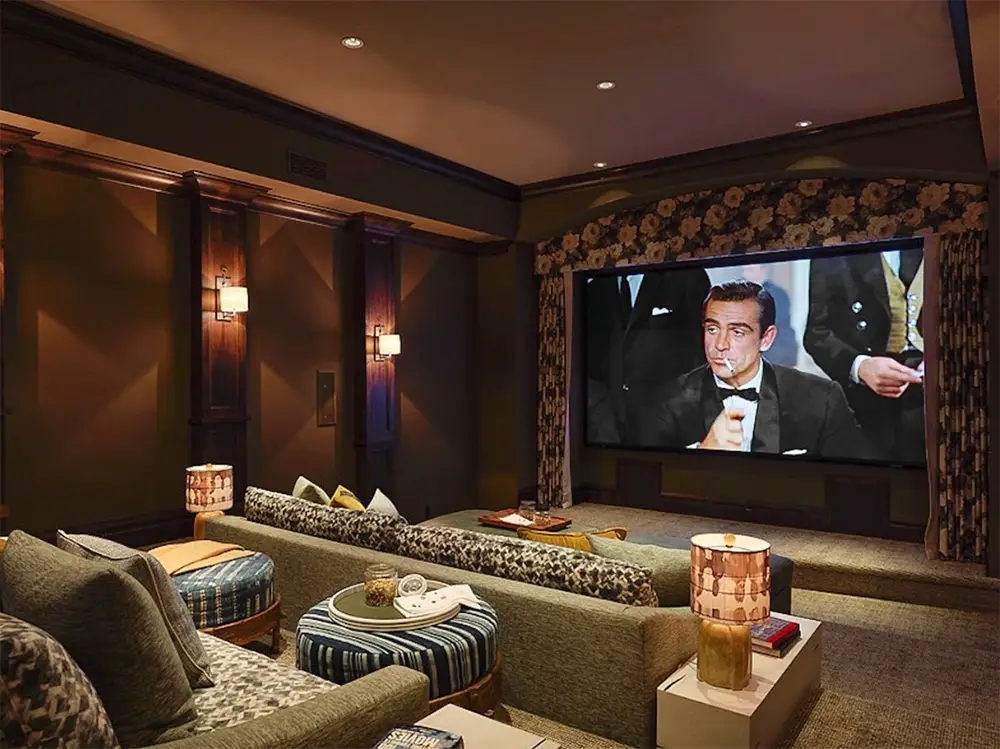
Sci-Fi Spectacle: A home theater enthusiast went all out with cool-toned LED strips that run along the ceiling and floor. These lights change color dynamically to match the themes of sci-fi movies, creating an immersive experience that transports viewers to other worlds.
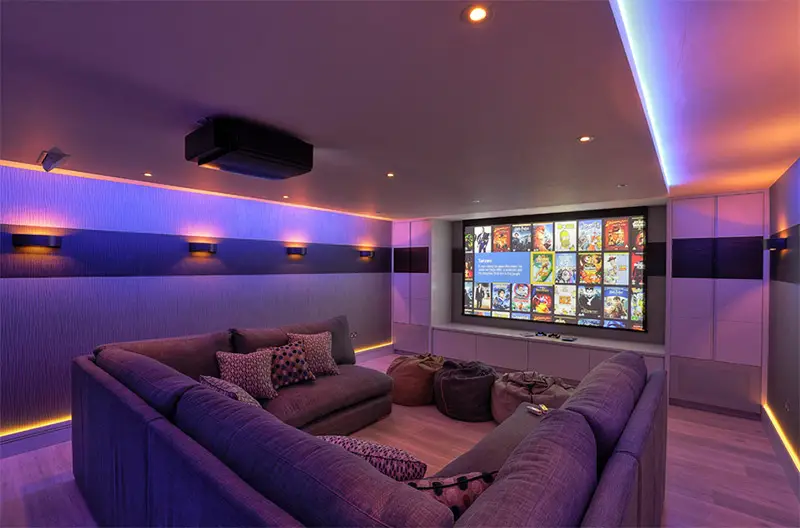
Minimalist Elegance: This home theater embraces a minimalist design with recessed lighting that illuminates the room evenly without distracting from the screen. Smart lighting control allows for easy adjustment of brightness and color temperature.
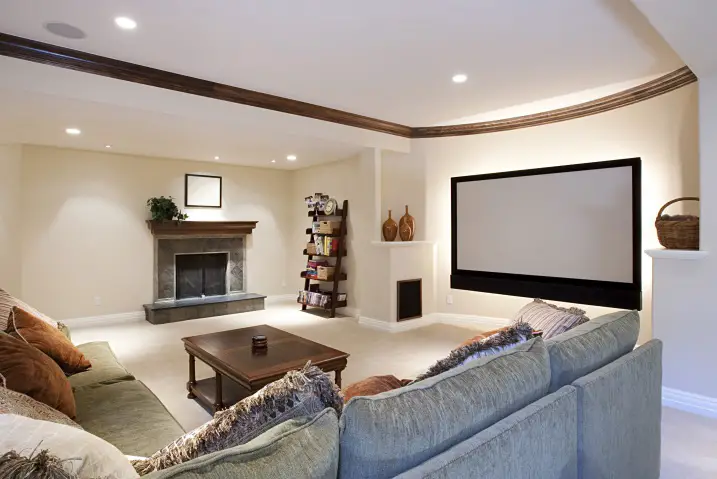
How Lighting Enhances the Overall Viewing Experience
In these examples, lighting isn’t just about brightness; it’s about enhancing the overall viewing experience:
- Mood Enhancement: The Cozy Classic example shows how the right ambiance can evoke nostalgia and set the mood for specific movie genres.
- Immersive Worlds: The Sci-Fi Spectacle demonstrates how dynamic lighting can transport viewers into the worlds of their favorite sci-fi films, adding an extra layer of excitement.
- Elegant Simplicity: The Minimalist Elegance design showcases how well-planned lighting can complement a minimalist aesthetic while providing the flexibility needed for various viewing scenarios.
Inspiration for Beginners to Get Started
These examples serve as inspiration for beginners to embark on their own home theater lighting journey. Whether you prefer a cozy atmosphere, a futuristic experience, or minimalist elegance, there are endless possibilities to explore.
Remember, the key to success lies in understanding the basics, choosing the right fixtures, experimenting with color, and considering smart lighting options. Because with the right guidance and a dash of creativity, you can create a home theater that’s uniquely yours.
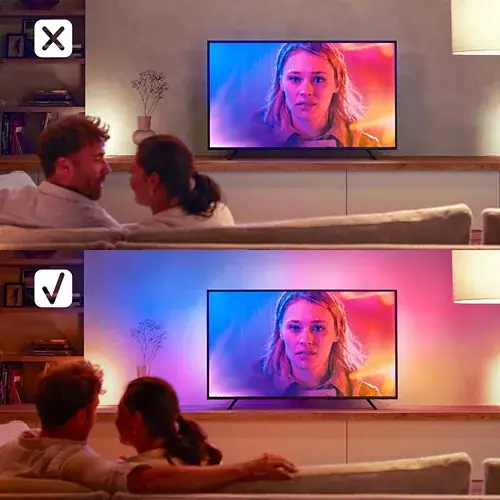
Conclusion
The Importance of Home Theater Lighting
In the world of home theaters, lighting plays a pivotal role in creating an unforgettable cinematic experience. Without a doubt it’s not just about seeing what’s on the screen; it’s about feeling the magic of the movies, immersing yourself in stories, and setting the stage for adventure, drama, or romance.
Throughout this “Home Theater Lighting Ideas for Beginners” guide, we’ve explored the significance of home theater lighting, from understanding the basics of ambient, task, and accent lighting to choosing the right fixtures, experimenting with color, and embracing smart lighting solutions. Additionally we’ve seen how well-placed lighting can enhance comfort, reduce glare, and add depth to your space.
Lighting and Beyond
But home theater lighting is more than just illumination; it’s a journey of creativity and personalization. Undeniably it’s about crafting an environment that reflects your style and enhances your viewing pleasure.
Experiment and Personalize Your Setup
As you embark on your home theater lighting journey, remember that there are no strict rules—only guidelines to help you get started. Therefore feel free to experiment, try different lighting scenarios, and let your imagination run wild.
Whether you prefer the warm embrace of classic cinema, the futuristic allure of sci-fi, or the sleek elegance of minimalism, home theater lighting can bring your vision to life. So, don’t be afraid to explore, learn, and create your perfect cinematic environment.
A Final Word
In closing, we invite you to embark on this exciting journey of home theater lighting. Remember that every tweak, every adjustment, and every choice you make in lighting brings you one step closer to an immersive cinematic experience that’s uniquely yours. So, dim the lights, grab your popcorn, and get ready for a world of movie magic right in the comfort of your home theater.
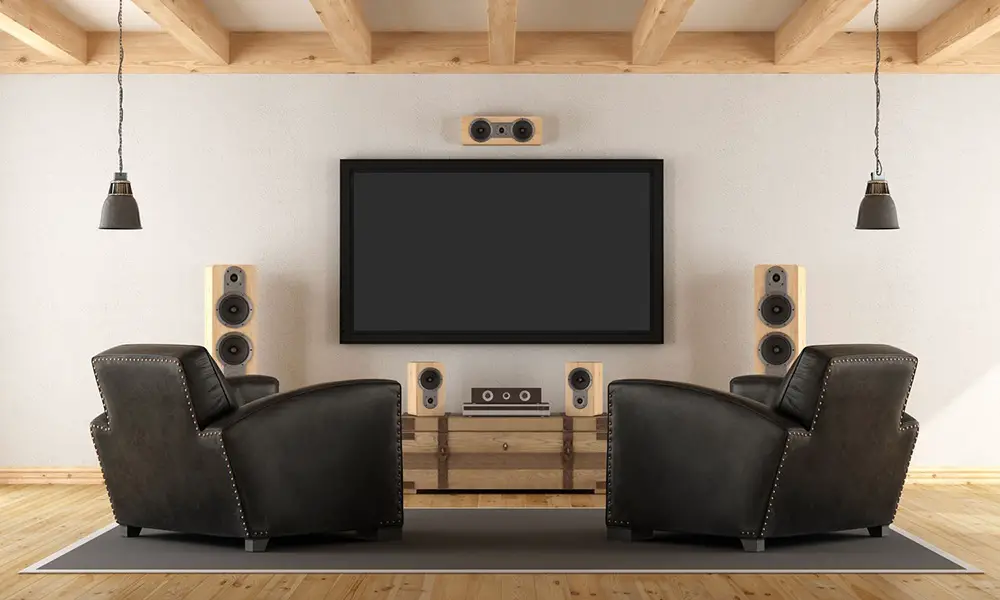
For more guides you can check our dedicated Guides section list.
This guide provides a valuable introduction to the often-overlooked but essential aspect of creating an immersive home theatre experience through effective lighting. Are there any specific products or brands you recommend for those interested in smart home theatre lighting solutions? Thank you in advance. Any suggestions would be more than welcome. Demi.
Hello Demi. There are many brands out there that make lighting products that can be used in home theater applications. Obviously Philips Hue is the most recognized one but they are also very expensive. You don’t have to go with that if you have a limited budget. There are many smaller brands that create smart lighting solutions, like Govee for example, and they are equally good.
Hi Stratos, I really enjoyed reading your article on home theater lighting ideas for beginners. It was very informative and helpful.
I agree with you that home theater lighting is an important factor that can enhance or ruin the movie-watching experience. Lighting can affect the mood, atmosphere, and quality of the image on the screen. Therefore, it is worth investing some time and money to find the best lighting solution for my home theater.
Whether people are looking to synchronize home theater lighting with movie sound or music initially or in the near future, what are the requirements for choosing the right products for this function?
Thank you for sharing your knowledge and expertise on this topic. I look forward to reading more of your articles in the future.
Hello Pablo. To be honest there are no real requirements. Home theater lighting is like a painting canvas. You shape it the way you like it and the way that makes you feel comfortable. Each person is different and seek different things. So we can give you only general guidelines but what you will use is definitely up to you. Movies and music is not so much different. Obviously there are some extra parameters, like the screen, that you have to take into consideration in terms of glare and reflections, something that does not apply with music. But otherwise both movies and music listening abide by the same principles.